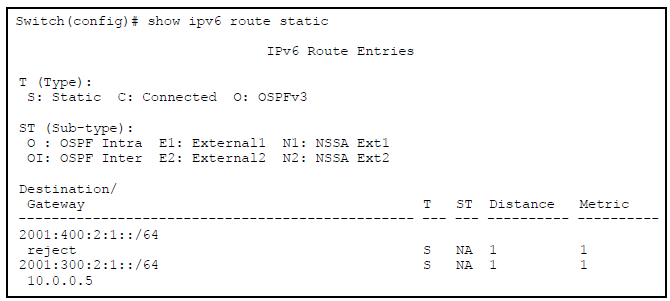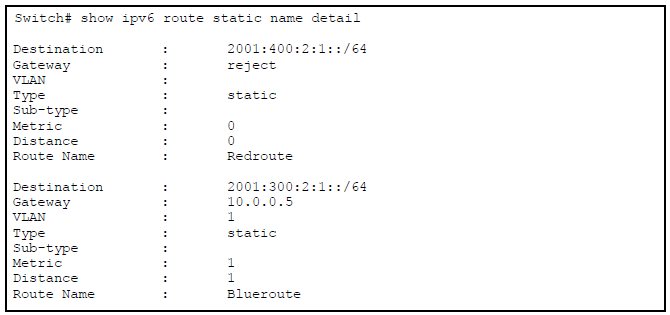Configuring an IPv6 Route
Syntax:
[no] ipv6 route dest-ip-addr / prefix-length [next-hop-gateway-addr | vlan vid | tunnel tunnel-id|blackhole|reject] [metric metric] [distance1-255] [tag-value tagval] [name <string>]
dest-ipv6-addr / prefix-lengthThe network prefix for the destination IPv6 address.
next-hop-gateway-addr|vlan <vid> | tunnel <tunnel-id>>The gateway for reaching the destination. The next-hop address option (link-local or global unicast) is not required to be directly reachable on a local subnet. (If it is not directly reachable, the route will be added to the routing table when a path to this address is learned.) If the next-hop address is link-local, it must include both the address and the applicable VLAN VID or tunnel <tunnel-id>. For example: FE80::127%vlan10, where VLAN 10 is the interface where FE80::127 exists. For a tunnel, it would be FE80::127%tun3.
blackholeSpecifies a null route where IP traffic for the specified destination is discarded and no ICMP error notification is returned to the sender.
rejectSpecifies a null route where IP traffic for the specified destination is discarded and an ICMP error notification is returned to the sender.
metricSpecifies an integer value that is associated with the route. It is used to compare a static route to routes in the IP route table from other sources to the same destination.
distanceSpecifies the administrative distance to associate with a static route. If not specified, this value is set to a default of 1. (Range: 1 to 255)
tagSpecifies a unique integer value for a given ECMP set (destination, metric, distance.)
name <name-str>Assigns a name to a static route.
The
no form of the command deletes the specified static or null route from the routing table.
Examples




Detailed Output of Named Static Routes in IPv6
